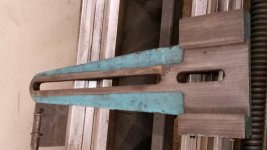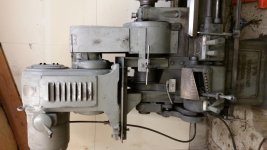I have an old American Tool works lathe that was saved from scrap by my father in law many years ago and it has been with a friend of ours getting occasional use until he needed the space and it moved to my shop last week.
I would like some help with the location of the serial number so I can find manufacture date, manuals, etc. It appears to have originally been flat belt drive, but has had a variable speed system bolted on top of the head stock which seems to work quite well. It is 24" swing and about 10' from chuck to tailstock, and it has a 22" four jaw that will replace the tiny three jaw currently mounted.
It has a taper attachment (neither of my other lathes has one) that is missing some components - if anyone has one of these and is willing to share pictures or specs of the pieces I need it would be appreciated. I am missing the piece(s) that fit between the first and the second pictures. The piece in the second picture tucks under the back of the cross slide - it is missing its gib.
Looking forward to getting this machine settled in and leveled Thanks!
I would like some help with the location of the serial number so I can find manufacture date, manuals, etc. It appears to have originally been flat belt drive, but has had a variable speed system bolted on top of the head stock which seems to work quite well. It is 24" swing and about 10' from chuck to tailstock, and it has a 22" four jaw that will replace the tiny three jaw currently mounted.
It has a taper attachment (neither of my other lathes has one) that is missing some components - if anyone has one of these and is willing to share pictures or specs of the pieces I need it would be appreciated. I am missing the piece(s) that fit between the first and the second pictures. The piece in the second picture tucks under the back of the cross slide - it is missing its gib.
Looking forward to getting this machine settled in and leveled Thanks!











